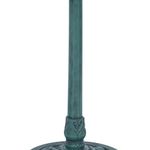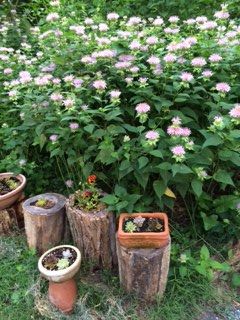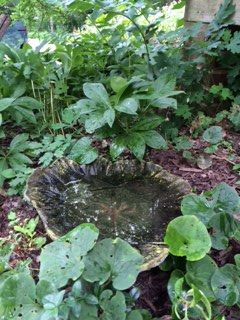
The garden is getting into full swing now; plants are finally established and many are flowering or just beginning to fruit. This is one of my favorite times of being a gardener–the garden is still looking good, sort of tidy and not too weedy (versus the unkempt look of late summer and fall)–and still anticipating the first ripe tomato and hot chile pepper.
There are new flowers, fruits, and growth spurts to check on daily. The pollinators are intoxicated from the bevy of blooms: monardas, calendulas, nasturtiums, arugula, day lilies, many of the mustards, squash blossoms, phlox and zinnies are just starting. I have a large patch of red-flowered monarda (Monarda didyma) on one side of the house and a patch of wild monarda with lavender flowers (M. fistulosa) on the other side. All day long the hummingbirds fly back and forth over the roof (not around the house) to vist both patches; they also love the phlox. I take delight when I see a big old bumble hanging heavy on the underside of a flower, where it will spend the night.
We feed the birds a mix of seeds at a feeder year round and there are many birds in and around the house and in the woods. There is a large patch of bamboo across the drive and many birds roost there at night. The birds start singing at about 4:30 am, however just a few every now and then; by 5 am there are more calling; and between 5:30 and 6:30 am there is a full-on concerto of bird song. While there is bird chatter all day long, the cacophony reaches a crescendo with evening song as they return to roost. This isn’t noise to me–they are pleasant, comforting, natural sounds. In fact, I tend to play less music this time of year and enjoy the birdsong.
Twilight is perhaps my favorite time of day and a perfect time to be in the garden. Many birds visit the garden at this time of day, grabbing a few insects before bedtime. I especially notice the cardinals–maybe because of their showy ponceau feathers. As I sit, the barn swallows fly overhead and the bats come out. If I wait long enough, the lightning bugs begin to rise out of their grassy lair and slowly ascend whereupon they reach the treetops by full-on darkness.
I have a large birdbath and two smaller ones. One of them is a large leaf shape and sits in a shade garden just off the backporch. The porch has a wooden railing so I can’t see the birdbath while sitting on the porch. In the summer, the family often eats supper at the picnic table on the porch. Every evening, catbirds come to take a bath. Have you ever heard a catbird take a bath? Well first they fly in and land on a low-lying branch of the pearl bush (which I can see). Then I hear them hop down into water and they make a splish-splash-splish. Next there is a small, raucous splashing with fluttering and lots of water movement… sometimes repeatedly. Finally, there is a shaking and fluttering of wings and the freshly bathed catbird hops back up on the the branch. Perhaps, there is a bit more fluttering which reminds me of a dog shaking water from its coat, and occasionally a bit of preening, before the bird flies off. If I stand up to watch this process, the bird flies off and we both miss this bathing ritual, and so I sit and listen, which is actually sort of more fun in some ways. It makes us sit still and really listen.
The sound of crickets is another story… The south side of our passive solar house is a greenhouse and the glass goes to the roofline; the second-story bedroom looks out through the upper part of the greenhouse. Well there has been a cricket in the greenhouse for the past five nights and although I haven’t seen it, I believe that it is pretty near the size of a small locomotive. It’s strange that for being so loud that I cannot find it. The cinderblock walls, brick floor, metal planting table and glass of the structure make the cricket’s call echo and causes a loud din. It starts up late evening and goes through the night until about 4-ish in the morning. If I turn on the light to find it, it stops making noise. After laying awake for a few hours each night, I actually got up and used earplugs to sleep. However, I stopped using them after a few nights and decided to just get used to it… which I have done, sort of…
So one night while I was lying awake listening to the dang cricket, until the birds started up, I was thinking about various calls that the birds make. Each bird sings a different song–actually all birds have more than a few calls–and they vary according to season. This is how they communicate among their species. Some calls are chatter, while there are calls for mating and then there are warning calls. I started wondering if the different species can understand one another or do they all speak different languages? So I read about birdsong and calls and indeed, they do speak a different language from one another. It’s like we humans, speaking Japanese and French and Spanish and English and German. However, birds do recognize warning calls amongst their feathered friends (heck, I recognize them too)… and they also are alerted by the warning call of squirrels.
Whatever language they are speaking, I find it sweet and comforting and it is perfect harmony when I am in the garden, whether it is morning, noon or night.
Fine Gardening Recommended Products

Alpine Corporation 28" Tall Outdoor Birdbath with Scrollwork Decoration Yard Statue
Fine Gardening receives a commission for items purchased through links on this site, including Amazon Associates and other affiliate advertising programs.

Plant Covers Freeze Protection 10 ft x 30 ft Floating Row Cover 0.9oz/yd²
Fine Gardening receives a commission for items purchased through links on this site, including Amazon Associates and other affiliate advertising programs.























Comments
Log in or create an account to post a comment.
Sign up Log in